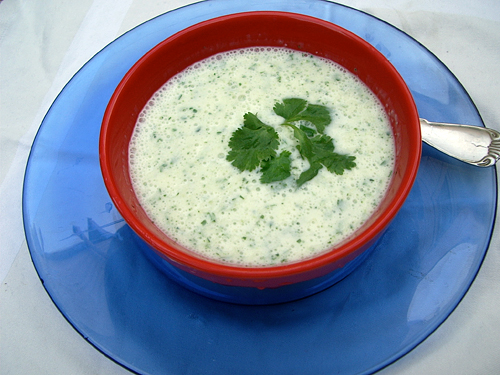After my own machine disappeared during my last move from Brooklyn back to San Francisco, I couldn't quite see adding yet another appliance to an already space-challenged kitchen. And why, when yogurt has been made for ages using absolutely no technology at all?
We give very little thought to the luxury (and relatively new phenomenon) of chilling milk straight from the cow, keeping it cold and fresh for a week or more at a time. Yogurt, like other ferments, makes this protein- and calcium-rich food last a lot longer, while at the same time making it easier to digest. Nomadic Mongolians fermented mare's milk in skin bags kept warm next to the saddle. All over the Mediterranean and the Middle East, yogurt was made from goat, sheep and (to a lesser extent) cow's milk. It could be made thin and tangy for use in marinades and drinks, richer and thicker for dips and sauces. In India, cooling yogurt-based lassi drinks could be salty or sweet, perfumed with aromatic spices or sweetened with pureed ripe mango.
It takes nearly no effort to make yogurt. What you need is milk (cow, goat, even sheep, depending on your preference), a little already prepared yogurt to act as a culture, a clean jar, and time.
A candy-type thermometer is useful, although not absolutely crucial. A quart of milk is a good amount to start with, along with 2 tablespoons of plain, unflavored yogurt made with live cultures (and preferably without pectin, gelatin, or other thickeners). Heat your milk up to 180 degrees F, until it's just starting to bubble up around the edges. Pour the milk into your clean jar and let it cool, stirring frequently. When it's between 110-115 degrees F, or when it feels just mildly warm to the touch, pour a little out into a small bowl. Whisk in the yogurt, then pour the mixture back into the jar. Whisk to mix, then cover the jar.
You're almost done. The last step is keeping the mixture at a more-or-less steady 110F to 115F for six to eight hours. Putting the jar into a large covered pot of 110-degree water that comes half-way up will work, as long as you periodically re-warm the water. Many people swaddle their jar in a thick towel and put it on top of the fridge or at the back of the stove, anywhere that stays reasonably toasty. That same half-filled pot of warm water could work very nicely stashed in a picnic cooler or styrofoam tub.
As the milk sits, the colonies of beneficial bacteria from the initial dose of yogurt will be digesting the lactose in the milk like crazy, kicking off a mad binge of reproduction. After some 6 to 8 hours, the once-fluid milk will be transformed into solid yogurt and a quantity of loose whey. Without stirring, put the jar into the fridge for several hours, so it can cool down and continue to set. Once the yogurt is thoroughly cold, pour off any excess whey, then stir thoroughly.
Try as you might, homemade yogurt is, in my experience, pretty runny. (So is commercial yogurt, if made from only milk, without added gelatin or pectin.) The more consistent your heat source, the better your chance for a more solid yogurt. Full-fat milk makes dreamy-rich yogurt, although I'm perfectly content using 2% milk for everyday use.
Once your yogurt is made, you can dress it up in many ways. Spooning it into a colander lined with cheesecloth, a clean tea towel, or several layers of paper towels, then letting it drain overnight in the refrigerator, will give you a fresh yogurt cheese similar to extra-thick Greek yogurt. You can sprinkle your yogurt cheese with herbs and sea salt, or drizzle it with honey and top it with toasted walnuts and oozing-ripe apricots.
Or you make your yogurt even runnier by turning it into a soup, like this chilled cucumber soup, drinkable even on the hottest East Bay days. It's also a way to redeem even the biggest, wateriest, seed-strewn cucumbers out of your garden, since the gelatinous seeds are scooped out and tossed, leaving only the cool flesh to be buzzed into a refreshingly frothy, herb-strewn puree.
Cool as a Cucumber Soup
The herbs in here are up to you. I think dill goes exceptionally well with cucumber, but basil, mint, or cilantro would all work very nicely, too.
Serves: 4
Ingredients:
3 cups plain yogurt
1/2 cup thick, drained yogurt, Greek style yogurt, or sour cream
1 garlic clove, peeled and chopped
2 tablespoons chopped chives or scallions
3 large cucumbers, peeled in alternating strips, halved, seeds scooped out
a generous handful of fresh dill, basil, cilantro or mint
a few sprigs flat-leaf parsley, optional
Salt and freshly ground pepper to taste
Preparation:
1. Combine yogurt, garlic, 2 cucumbers, and herbs in a blender. Puree until fairly smooth. You may have to do this in batches to avoid overloading your blender.
2. Pour soup mixture into a large pitcher and set aside. Grate or finely dice remaining cucumber and stir in for texture. Taste and add salt and pepper as needed.
